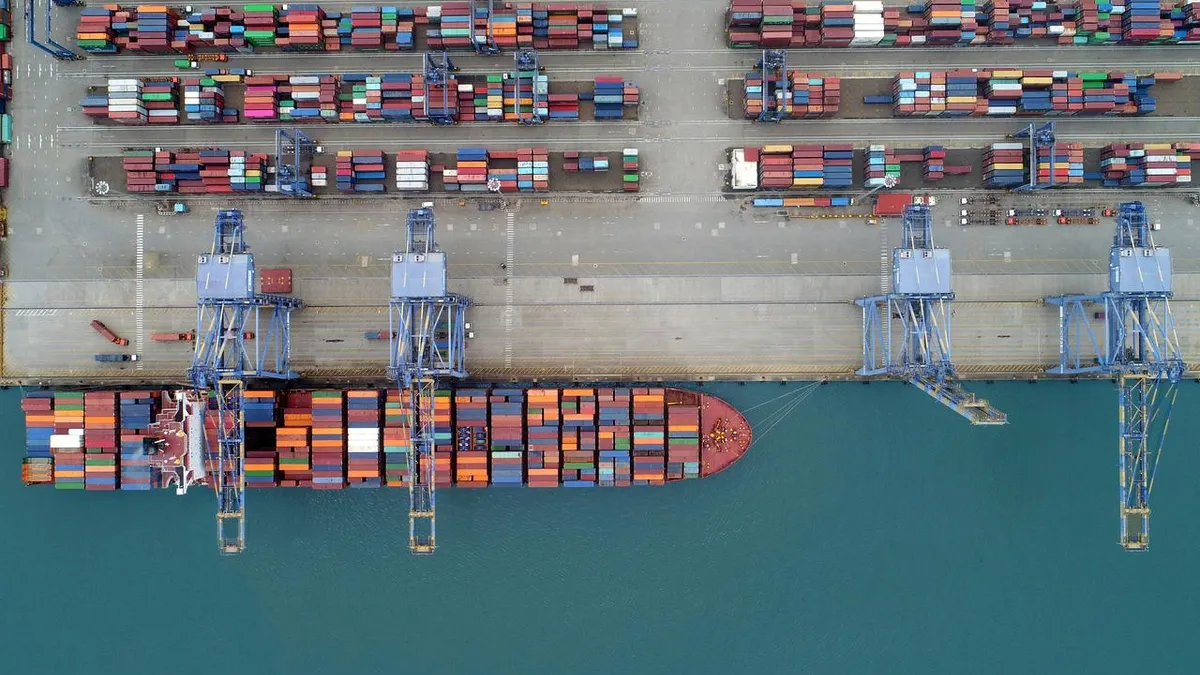Geopolitical upheaval has taken its place beside natural disasters and the lingering impact of the COVID-19 pandemic as top threats to supply chain resilience. From shifting trade policies and tariffs to rising political tensions and regulatory unpredictability, these forces are upending global operations and driving up costs.
This volatility is sending supply chain managers back to the drawing board as they discover traditional risk mitigation strategies on their own may not be enough to counter the unique challenges of geopolitical disruption.
Supply chain disruptions come with real, measurable financial consequences. The 152 supply chain, operations, and IT executives responding to a new survey by Supply Chain Dive’s studioID and DP World revealed that over the past three years, their companies have lost a median of 5% of revenue to supply chain disruption of all types. Other estimates have pegged the financial cost of disruption at 6-10% of annual revenues (Economist Impact), which stretches up to 15% for small and mid-sized businesses (Supply Chain Brain).
“Five percent is a pretty sizable percent of revenue, and that signals the need for action,” says Brittany Caskey, chief commercial officer — logistics, for DP World Americas.
It’s clear that geopolitical disruption is no longer a periodic shock — it’s a persistent and escalating threat. More than four in five (82%) of respondents say geopolitical events present a moderate to significant risk to their supply chains, and 78% expect that risk will increase in the next two years. Inflation and tariffs lead the list of geopolitical concerns.
Two surprising findings of the survey should grab the attention of any organization with a supply chain:
- Fully half of respondents are only “somewhat prepared” to deal with the impacts of geopolitical disruption.
- Some of the highest-performing strategies to deal with geopolitical disruption are also the least adopted — despite being relatively simple to implement.
To increase resilience in the face of strong geopolitical headwinds, it’s critical to better understand the sources of disruption and prioritize mitigation strategies that protect revenue and reputation. Forward-thinking companies are building geopolitical agility through smarter partnerships, more proactive policy engagement, and better use of data and technology.
Fierce geopolitical headwinds
The biggest effects of geopolitical disruption are showing up in volatility in materials pricing (36%), increased shipping costs (36%) and disruptions in access to critical suppliers and markets (33%). Even the hint of such impacts can negatively impact an organization.
“Look at how the tariff announcement impacted Wall Street and stock prices. Companies have to start thinking about stock buyback programs, pension funding shortfalls,” says Caskey. “Just uttering the words of potential geopolitical disruptions can materially change the financial status of a company without the company even doing anything. That's scary.”
The data shows that traditional mitigation tactics — while familiar — aren’t always the most effective.
So far, respondents have been turning to familiar moves from the disruption mitigation playbook:
- Increasing collaboration with supply chain partners (49%)
- Diversifying suppliers to achieve a geopolitical/location advantage (47%)
- Devoting additional resources to supply chain risk management (37%)
But compare that with the top strategies respondents admit are actually very or extremely successful for mitigating geopolitical risk in their supply chains:
- Moving or adding internal operations in a location for a geopolitical advantage (73%)
- Elevating compliance with policy/regulation to the boardroom level (67%)
- Increasing investment and/or activity to influence policy decisions (66%)
- Seeking additional data on the political risk and/or risk mitigation activities of our suppliers and/or sub-suppliers (66%)
Lots of these underused strategies can be implemented rather quickly and easily. So while traditional strategies have their role, the best way forward may be to combine both traditional and under-used strategies to better weather disruption and outperform competitors.
A smarter approach
High-performing organizations are investing in scenario planning, real-time risk monitoring, location-based diversification, and proactive policy engagement as they move forward into an uncertain future. These strategies don’t just mitigate risk; they create flexibility, enhance agility, and safeguard continuity.
And they’re not doing it alone. Resilience depends not only on internal readiness but also on the strength and flexibility of the ecosystem. Supplier and logistics provider capabilities are shaping procurement decisions, so evaluating a partner’s geopolitical agility is becoming essential to long-term success.
The survey found 89% of respondents see suppliers’ approaches to geopolitical risk management as playing a significant or moderate role in their companies’ supplier selection processes. In fact, 78% have added or switched a supply chain provider due to the geopolitical advantage of a location where they do business (e.g., to avoid a tariff or sanction).
Geopolitical upheaval may be inevitable, but how an organization prepares and responds is firmly within its grasp. By aligning leadership, strategy, and ecosystem partners around geopolitical risk readiness, supply chains can shift from vulnerable to future-proof.
“It really comes down to physical infrastructure, systemic infrastructure, agility, being prepared, but also already having options ready to go,” says Caskey.
For a deeper dive into the survey results and the state of geopolitical risk, download the full report.










